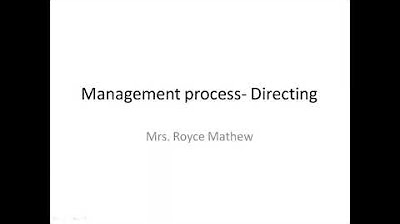Fungsi Manajemen Pelaksanaan dan Pengawasan
Summary
TLDRThis video discusses the two essential functions of management: implementation and supervision, particularly within the context of education. It explains how effective management involves planning, organizing, implementation, and supervision. The implementation phase focuses on motivating and guiding team members to achieve organizational goals, while supervision ensures that the plans are executed correctly. Key elements such as leadership, motivation, communication, and decision-making are highlighted, alongside practical steps for managing educational institutions. The video emphasizes the importance of monitoring, evaluation, and corrective actions to maintain educational quality and continuous improvement.
Takeaways
- 😀 Effective management involves both implementation (pelaksanaan) and supervision (pengawasan) to achieve organizational goals.
- 😀 Implementation ensures that plans are executed efficiently, while supervision focuses on monitoring and evaluating the process to ensure success.
- 😀 The four key management functions in education are: planning, organizing, implementing, and supervising.
- 😀 Leadership, motivation, and communication are essential for effective implementation in education management.
- 😀 The role of leadership is critical in motivating and guiding the team to achieve the organization's objectives.
- 😀 Motivation drives productivity, and it is important for leaders to understand and support their team's needs.
- 😀 Communication helps in clearly defining goals, roles, and responsibilities, preventing misunderstandings during task execution.
- 😀 Effective decision-making is necessary to ensure smooth operations and to keep the organization on track.
- 😀 In education, tasks should be assigned based on expertise and interests to ensure optimal performance and outcomes.
- 😀 Supervision in education management includes setting standards, monitoring performance, conducting evaluations, and implementing corrective actions when necessary.
- 😀 Regular evaluations help to identify gaps between planned and achieved goals, leading to improvements in educational programs.
Q & A
What is the main purpose of the function of Pelaksanaan (Implementation) in educational management?
-The main purpose of Pelaksanaan is to ensure that the planned strategies and activities are executed effectively and efficiently in an educational institution, aligning with the institution's objectives.
How does Kepemimpinan (Leadership) contribute to successful implementation in education?
-Kepemimpinan plays a crucial role by guiding and motivating the team, setting clear direction, and creating an environment conducive to collaboration and goal achievement within the educational organization.
Why is motivation important for staff in educational management?
-Motivation helps to boost productivity and engagement among staff. Leaders can use various methods like training, incentives, and recognition to ensure staff remain dedicated and aligned with the institution’s goals.
What role does communication play in the implementation process in educational management?
-Effective communication ensures that all members understand their roles, responsibilities, and the organization’s goals, which helps prevent misunderstandings and ensures smooth execution of tasks.
What is the significance of Pengawasan (Supervision) in educational management?
-Pengawasan is essential for monitoring the progress of activities and assessing if the plans are being executed correctly. It helps in identifying problems, ensuring efficiency, and maintaining the quality of educational programs.
What are the main components involved in Pengawasan (Supervision)?
-The key components of Pengawasan include setting standards, monitoring performance, evaluating outcomes, and taking corrective actions if deviations from the plan occur.
How do standards and criteria help in the supervision process?
-Standards and criteria serve as benchmarks to evaluate if the activities align with the planned objectives. They ensure that the institution’s operations meet the expected quality levels.
What are the steps involved in effective supervision within educational management?
-The steps in effective supervision include setting quality standards, monitoring performance, conducting regular evaluations, and implementing corrective actions such as revising curriculum or offering training programs.
How can corrective actions improve the educational process?
-Corrective actions, like staff training or curriculum changes, help address deviations from the plan and ensure that the educational goals are met. They keep the process aligned with the institution’s mission and vision.
How does the case study in the transcript demonstrate the importance of implementation and supervision?
-The case study illustrates that effective implementation requires clear leadership, motivation, communication, and decision-making. It also highlights the importance of supervision in assessing performance, making adjustments, and ensuring the success of educational programs.
Outlines

This section is available to paid users only. Please upgrade to access this part.
Upgrade NowMindmap

This section is available to paid users only. Please upgrade to access this part.
Upgrade NowKeywords

This section is available to paid users only. Please upgrade to access this part.
Upgrade NowHighlights

This section is available to paid users only. Please upgrade to access this part.
Upgrade NowTranscripts

This section is available to paid users only. Please upgrade to access this part.
Upgrade NowBrowse More Related Video

Management Process- Directing

Video Pembelajaran | Kurikulum Nasional | Seni Budaya | Manajemen Musik Seni Musik Kelas X

Micro Learning PKTBT Materi Organisasi di Lingkungan Kemendikbudristek Bapak Yudi Pramudianto

Fungsi Manajemen Pelaksanaan dan Pengorganisasian

06. Human Capital Management - Theory

Seri #1 PNBP: Pengelolaan PNBP.
5.0 / 5 (0 votes)